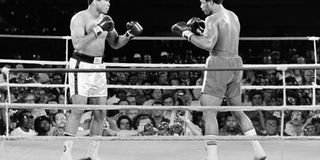Breaking News: CDF Francis Ogolla involved in KDF chopper crash
Come hell or high water, the only space I will be found in is the sports pages

This file photo taken on October 30, 1974 shows the fight between US boxing heavyweight champions, Muhammad Ali (L) (born Cassius Clay) and George Foreman in Kinshasa. PHOTO | AFP |
What you need to know:
- Many people ask me why I chose to become a sports journalist with the clear implication that I could be writing on more “serious” subjects. And I ask them: don’t you get sick of what goes on in the front pages? Each time I see a splash about the 2022 Kenyan election, I feel as if I am being exposed to radiation.
To the people who repeatedly ask me why I chose to become a sports journalist, here is one last attempt at explaining myself. I say last without much conviction; I strongly suspect I will have to do it again immediately you finish reading this piece.
Many people ask me this question with the clear implication that I could be writing on more “serious” subjects. A few mince no words: I am “wasting” my talents on the back pages of the newspapers.
And I ask them: don’t you get sick of what goes on in the front pages? Each time I see a splash about the 2022 Kenyan election, I feel as if I am being exposed to radiation. It is so hazardous. Why not about the 2022 Fifa World Cup and what we are doing to qualify? In moments of self-doubt, I have actually tried to vacate the sports pages but I ended up getting so bored that I developed a toothache.
No, I am not going to write about politics and I am not going to write about business and I am not going to write about farming. I am not going to write about macadamia nuts because I am sure I will end up going nuts myself. I eat them but I am not going to write about them. I have tried it before and it has not worked and I am not going to try it again. Our people say “tosha gari” when the vehicle is full. In my case it is full and it has left. Enough.
I will never leave the only pages when I am not only allowed but actually expected to use hyperbole. When I was a little boy, I read a story by Hezekiah Wepukhulu, the father of Kenya’s sports journalism.
He wrote that Vincent Mwenje’s blockbuster shot had beaten the goalkeeper only to be stopped by the woodwork. I knew for a fact that Nairobi City Stadium goalposts were made of steel and yet there was no correction to that report. In fact, it was repeated several times in the future.
Later, in the count-down to the 1974 World Cup, I read about Roberto Rivelino’s free-kicks. They were grass cutters. I knew a ball can’t cut grass and yet this was coming from the giants of the trade, international news agencies like AFP and Reuters. And it all passed. And so I ask: where will I get the superhuman skill needed to make describing how to dry coffee beans interesting? Or how to safely store ripe mangoes?
I can’t escape politics because it runs my life and so I must skim the front pages after going over every last filler in Nation Sport with a fine tooth comb. But politics is boring; important yes but boring to the back teeth. Want inspiration? Want to lift yourself to where you truly belong? Sports is where to be.
While engrossed in a book writing project, I stumbled on something. Because it wasn’t what I was looking for, it turned out all the more interesting. This is the evolution of sports journalism in Kenya. I can assure you that those sleek dispatches you have been reading from our reporters in Gold Coast and Moscow lately have come a very long distance – in time, not kilometres.
Let me give you a window into how a football match was reported in 1933. This was a match between Mombasa and Nakuru. As you can imagine, the report was in the East African Standard, the sole newspaper of the time because the Nation would not be born until 1960.
Here’s the intro: “The visitors kicked off and Mulholland immediately became prominent with some trick work, he and Atherton invading, but it was up to the homesters to become dangerous first, the attack ending in a dropping shot which Campbell cleared. The visitors replied with a good clearance by Newsam and then Atherton went through in the centre and put in a stinging shot which Ramage cleverly got away. It was ding-dong work for the next ten minutes, both goals being threatened, the visiting forwards showing the best constructive movements.”
Sorry, I won’t reprint the full report. But I will give you a snippet of what the paper called “Critique” at the end: “It was a hard, rousing, cup-tie game with plenty of hard knocks but no suspicion of bad feeling from beginning to end. Although beaten, the visitors were far from disgraced, putting up a spirited fight after their two day’s journey and only in the last few minutes did they show any signs of wear.”
You judge for yourself because I will say no more on that one. But I can’t help recalling Kisumu County versus Kakamega County or what they called themselves in 1945. The headline was simple - Remington Cup Final. It was followed by the score-line C. Kavirondo: 4 N. Kavirondo: 2.
Now the report: “Central Kavirondo won the Remington Cup for 1945 (the Arab and African inter-district association football competition) by beating North Kavirondo in the final at the Nairobi Native Stadium on Saturday by 4-2, having led 3-2 at half time. It was a fast interesting game, despite the fact that the football was of the Cup-tie, kick and run variety rather than the close, cohesive game which some of the better league sides can display. Central Kavirondo won on their merits.”
Again, that is all I have to say.
Did I talk about hyperbole and getting away with it? Well, that is how we do our job at the sports pages. In the Daily Nation of Tuesday, April 27, 1971, I found an absorbing account of how Young Rovers were beaten 6-0 by Black Mamba in a contest to decide the fourth Nairobi team to take part in the national super league. It’s headline? “Rovers eaten by Mamba.” English translation of Mamba from Swahili - crocodile.
Of course, Rovers showed up in many subsequent matches and that report merely irritated rather than alarmed their supporters and loved ones.
The current runaway league leaders, Gor Mahia, have received more sports journalists’ exaggerations than they have Cups. The Daily Nation of Friday, November 19, 1976 did not think they were up to the task of defeating Mombasa’s Nyundo in a KFF Challenge Cup quarter-final match, despite the fact that they were the reigning league champions. It posed this headline question: “Nyundo to hammer Gor Mahia?” In case you don’t know, nyundo is the Swahili word for hammer.
There was an honesty in the 1970s that has been replaced with suffocating hypocrisy today. At that time, a spade was a spade and the story ended there.
While people in Kenya are now so conscious of their tribal identities that they can even contemplate breaking up the country in many mono-ethnic nations, you will definitely not read in any newspaper the equivalent of this report that appeared in the Daily Nation of Friday, November 26, 1976:
“Edward Wamalwa, Abaluhya and Kenya international midfielder, yesterday announced his resignation from Abaluhya Football Club, and may play for the East and Central African club champions, Luo Union, next season. Wamalwa, who has been a regular Abaluhya player since 1969, will make history if he joins Luo Union as no player of the Abaluhya tribe has played for a Luo club.”
I am wary of any addiction but I tightly embrace hyperbole in sports journalism. It gives wings to my imagination and wipes out the dreariness of business, politics, farming and anything else that I could write about. It pumps oxygen into my system. It sustains me. Once long ago, I subscribed to a long defunct magazine called South and, inspired by my discoveries of the writings of the 1920s, 30s and 60s, I remembered a duel between the famed Afro-Trinidadian writer, CLR James and Denys Rowbotham, a journalist for the Guardian newspaper in Britain.
It was about a West Indies cricketer named Garfield Sobers. I breathlessly searched my study and luckily found the magazine. I just took in the fresh air after getting to the page I was looking for. Rowbotham had described Sobers thus: “Nature indeed has blessed Sobers liberally, for in addition to the talents and reflexes, conditioned and instinctive of a great cricketer, he has the eyes of a hawk, the instincts and suppleness of a panther, exceptional stamina and apparently the constitution of an ox.”
CLR James was miffed by this description, which I loved without knowing Sobers. He penned a furious rejoinder. It opened thus: “Garfield Sobers is a West Indian cricketer, not merely a cricketer from the West Indies. He is the most typical West Indies cricketer that it is possible to imagine. All geniuses are merely men who carry to an extreme definitive characteristics of the unit of civilization to which they belong and the special act or function which they express or practice. Therefore, to misunderstand Sobers is to misunderstand the West Indies, if not by intention, by inherent predisposition, which is much worse.”
He added: “I react strongly against (this description). I see Sobers always. His action as a pace bowler is the most orthodox that I know. There is nothing of the panther in the batting of Sobers. He is the most orthodox of batsmen. His captaincy has the same measured, one might say, classical character. I have met his people, listened to his mother talk about her son; he is a West Indian of the West Indies. But he is a citizen of the world today.”
The edition of South I quote is dated September 1985 but the poetry in the passages has stayed with me since. I thought then: only sports journalism can give me this. Sublime. Personal.
This is my space. But there is more. Sports journalism has the world’s best punch lines. I will borrow one to declare my victory against those people who are urging me to leave it. Muhammad Ali said: “I saw George Foreman shadow-boxing. The shadow won.”




